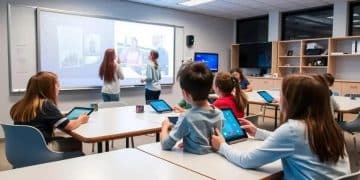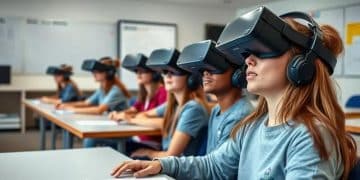AI in classrooms trends: enriching learning experiences
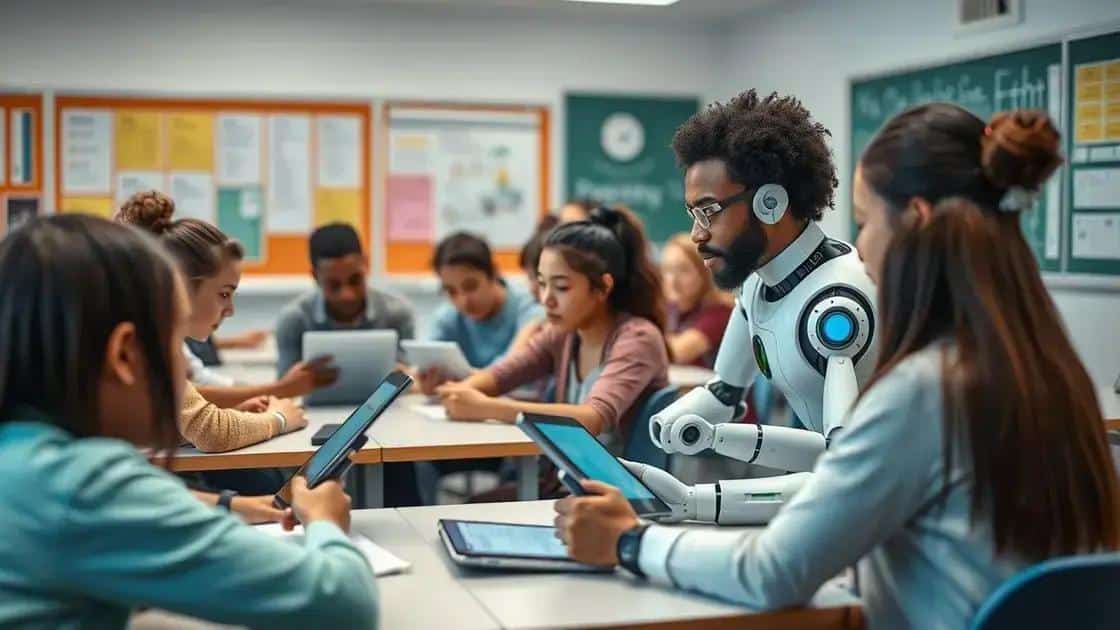
AI in classrooms trends focus on enhancing personalized learning, utilizing virtual and augmented reality for immersive experiences, and transforming assessment methods to foster student engagement and creativity.
AI in classrooms trends are reshaping education as we know it. Imagine a classroom where each student learns at their own pace, thanks to intelligent technology. It’s fascinating to see how these advancements can enhance engagement and tailor learning experiences for every individual.
Transforming traditional teaching methods with AI
In today’s world, transforming traditional teaching methods with AI is becoming increasingly important. As AI technology advances, it brings new opportunities for enhancing education. This shift can create more engaging and effective learning environments.
Shifting from Lecture to Interactive Learning
Traditionally, classrooms have relied on lectures as the primary mode of instruction. However, AI tools are changing this dynamic. With the use of AI-powered platforms, teachers can foster collaboration among students. For example, learning management systems can provide personalized resources tailored to individual student needs.
Enhancing Teacher-Student Interactions
AI applications are not only transforming how content is delivered but also enhancing interactions in the classroom. Educators can leverage chatbots for immediate feedback during lessons. This can help clarify concepts in real-time and allow teachers to focus on areas where students struggle the most.
- AI can analyze student performance data.
- Customized feedback allows students to improve.
- Teachers save time on administrative tasks.
- More time for personalized teaching.
Additionally, AI tools facilitate communication between students and teachers. By using platforms that support messaging, students can ask questions outside of class hours. This ensures that they have access to support whenever they need it, making learning more accessible than ever.
Promoting Inclusive Learning Environments
Another crucial benefit of transforming traditional teaching methods with AI is the promotion of inclusive learning environments. AI technology helps to cater to diverse learning styles. For instance, educational applications can provide visual aids for visual learners while offering detailed readings for those who excel with textual information. This customization ensures that every student can engage with the material in a way that makes sense to them.
As we continue to see progress in AI technology, the future of teaching looks promising. By integrating AI into educational practices, we can expect increased student engagement and improved learning outcomes. It’s an exciting time for both educators and students, as the classroom evolves to meet the needs of a digital age.
Personalized learning experiences through AI features
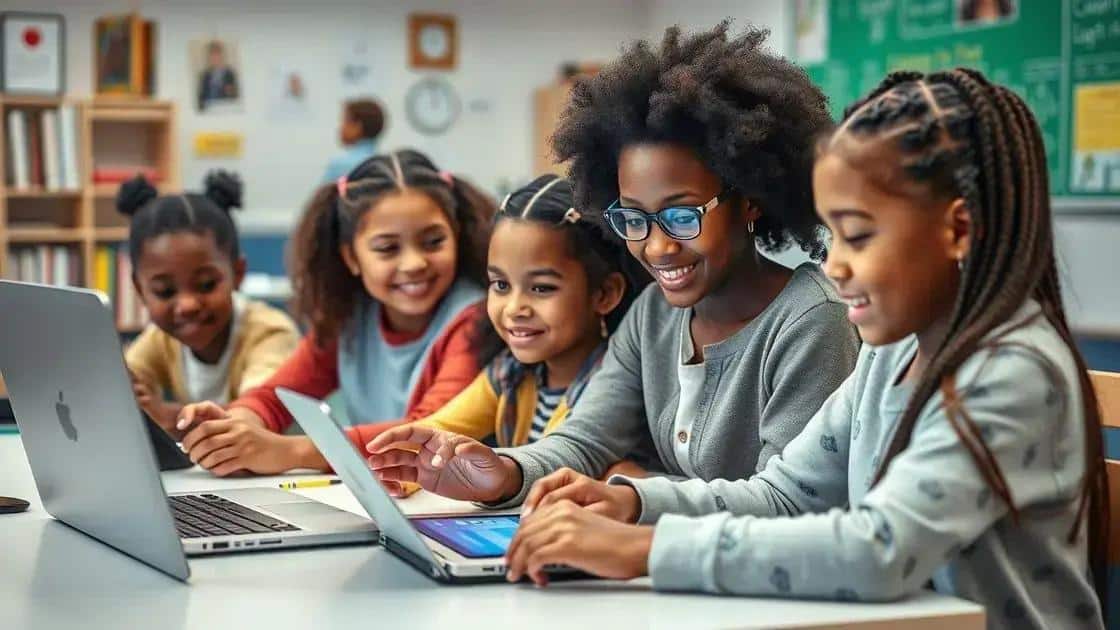
Personalized learning experiences through AI features are changing the educational landscape. With AI, schools can tailor lessons to meet each student’s individual needs. This approach helps students learn at their own pace, making education more effective and enjoyable.
Understanding Student Strengths and Weaknesses
AI can analyze data quickly to determine each student’s strengths and weaknesses. By evaluating test scores and engagement levels, AI systems provide valuable insights into how students learn best. This information allows educators to create customized lesson plans aimed at improving weak areas.
- AI tracks student progress in real time.
- Data-driven insights help personalize instruction.
- Adaptive learning platforms adjust difficulty based on ability.
- Identifying learning styles enhances engagement.
With these insights, teachers can modify their teaching methods. For instance, if a student struggles with reading comprehension, an AI tool can suggest additional resources and exercises to improve these skills. This level of personalization boosts confidence and helps foster a love for learning.
Engaging Learning Platforms
Another significant element of personalized learning through AI is the use of engaging platforms. Many educational software programs utilize AI algorithms to adapt to each user. These platforms create interactive lessons that keep students interested and motivated. They can also incorporate gamification, making learning feel less like work and more like play.
As students interact with these tailored programs, they receive instant feedback. This immediate response encourages them to try again or to explore different strategies. It can make a significant difference in a student’s willingness to engage with challenging subjects.
Moreover, with access to AI-driven resources, students have more control over their learning journeys. They can choose topics that interest them, explore advanced materials, or revisit concepts they find difficult. This autonomy fosters a deeper understanding and greater retention of information, ultimately leading to better academic performance.
The role of AI in classroom management
The role of AI in classroom management is gaining recognition as technology becomes more integrated into education. Teachers are leveraging AI tools to streamline tasks, improve organization, and enhance student engagement.
Streamlining Administrative Tasks
One significant benefit of AI in classroom management is the ability to automate administrative tasks. For instance, AI software can manage attendance, grade assignments, and handle scheduling. This automation frees up valuable time for teachers, allowing them to focus more on instruction rather than paperwork.
- Automatic grading saves time and provides quick feedback.
- Attendance systems can track students easily.
- Scheduling software assists in organizing lessons.
- Data analysis helps identify areas needing attention.
By using these tools, educators can create a more efficient workflow, reducing stress and improving the learning environment. The time saved on administrative duties can be redirected to developing engaging lesson plans and supporting students personally.
Enhancing Student Engagement
AI also plays a vital role in enhancing student engagement within the classroom. By providing personalized learning experiences, students feel more invested in their education. AI can analyze how students interact with content and adjust lessons accordingly. This means that if a student struggles with a topic, the AI can provide additional resources or alter the presentation of the material.
Furthermore, interactive AI tools can facilitate group activities, encouraging collaboration among students. These platforms often incorporate games and challenges, making learning fun and interactive. This engagement not only helps with retention but also fosters teamwork and communication skills.
AI’s role extends to monitoring student behavior and providing insights to teachers regarding participation. With these insights, teachers can modify their approaches and address issues promptly. The result is a more harmonious classroom where students feel valued and motivated.
Future predictions for AI in education
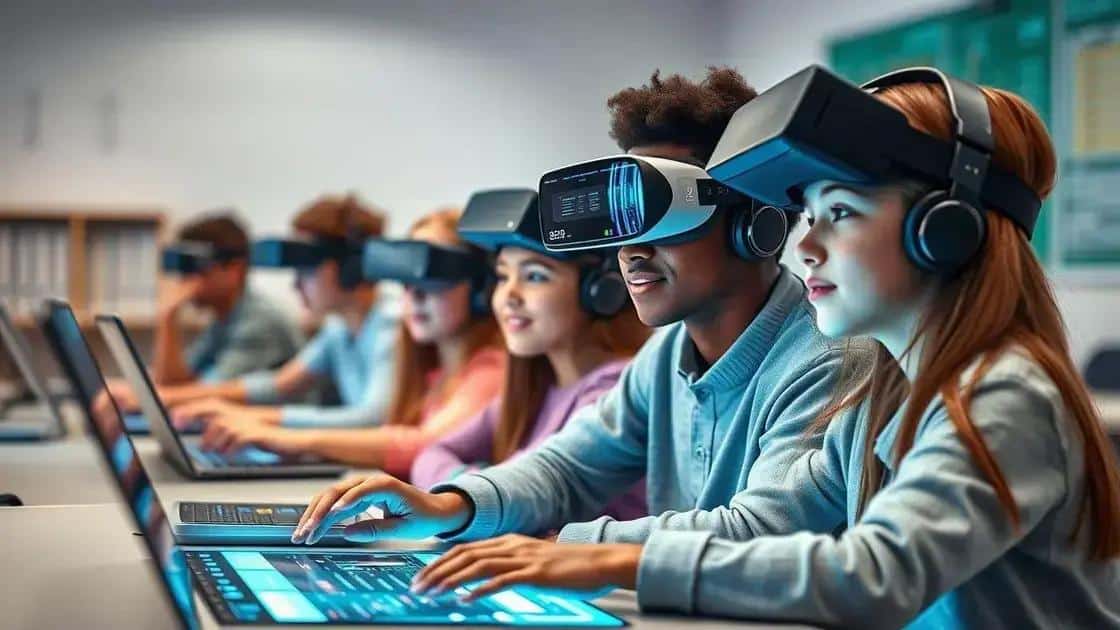
Future predictions for AI in education suggest significant changes that could reshape learning experiences. As technology evolves, educational systems must adapt to keep pace with advancements in artificial intelligence.
Enhanced Personalization
One of the main predictions is an increase in personalized learning. AI will analyze student data more intricately to tailor educational content. It will help identify areas where students need more support and suggest resources to enhance their learning. Customized learning paths will allow students to progress at their own pace, making education more effective.
- AI will create individualized lesson plans based on student performance.
- Students can choose from various resources suited to their learning styles.
- Real-time feedback will guide academic growth.
- Students will have more ownership of their learning journeys.
This personalization will not only help in knowledge acquisition but also in building confidence as students see their progress.
Incorporation of Virtual and Augmented Reality
Another prediction is the greater use of virtual reality (VR) and augmented reality (AR) in classrooms. These technologies will make learning more immersive and engaging. Students could explore historical events or scientific phenomena through interactive experiences. With AI assisting in these technologies, the learning environment will become more dynamic.
These tools have the potential to captivate students’ interest, making tough subjects easier to grasp. Imagine studying a historical battle as if you were there or visualizing complex biological processes in three dimensions. Such experiences will enhance understanding and retention of information.
As AI continues to develop, we can also expect advancements in assessment methods. Traditional exams might be replaced with a more holistic approach to evaluating students. AI will provide detailed insights into skills like critical thinking, creativity, and collaboration. This comprehensive evaluation will help recognize each student’s unique talents and areas for growth.
FAQ – Frequently Asked Questions About AI in Education
How does AI personalize learning for students?
AI analyzes student data to tailor lessons, providing customized learning paths that help students learn at their own pace.
What role do virtual and augmented reality play in education?
Virtual and augmented reality create immersive experiences that engage students, helping them better understand complex topics.
How will assessment methods change with AI?
AI will enable more holistic evaluations, focusing on skills and creativity rather than traditional testing methods.
How does AI enhance student engagement in classrooms?
AI tools facilitate interactive learning and provide immediate feedback, increasing motivation and fostering a positive learning environment.

